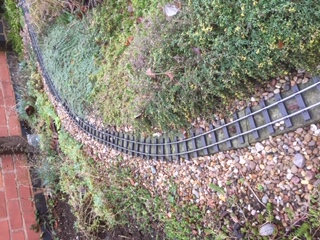Hello Readers,
I mentioned my 'wandering' track alignment in my New Year post, I have an update.
One advantage of having the railway is that the garden is much lower maintenance, thanks to plenty of ground cover plants and a reduction in 'crop' plants. Most of the growing is done on the allotment these days but I still have a few fruit bushes and a row of raspberries. The raspberries are old now and and some of the canes died off last year, however, there are plenty of healthy roots pushing out from the canes, some came up very close to the railway and needed moving to avoid some incongruously giant foliage beside the track. This afternoon seemed like a good opportunity so I set too and removed the strays to the proper run of canes. This job took me into places I don't often get and thus gave views along the railway I don't normally see. To my horror the alignment problems mentioned are, in places, far worse than I thought. In fact, the kinks are so severe that I'm pretty sure they are bad enough to fetch anything I ran at the moment off the road. I can't pin-point the cause but the problems all see to exist where the maximum amount of 'terra forming' took place to create the railway. I thought I'd thoroughly compacted the ground as it went back in, ramming it with a punner in thin layers, but nevertheless it can only be ground movement which has done this. Many of the 'kinks' are outward, so if it was thermal movement of the track it would need hot weather to cause it - this has been noticeably absent in North West Leicestershire of late! No matter what the cause, I can see no option but to unpin the track and ease out the alignment to something trains can run over smoothly. If it happens again I'm going to seriously consider reconstructing the formation. That would be a nightmare but better than having this palaver every year!
This may not look bad but it's far worse than the alignment I originally layed.

- 2021 track misalignment1.JPG (63.51 KiB) Viewed 5569 times
This curve is on an embankment between 6" and 12" high on about 2' of filled ground (I was mining sand and gravel from a natural deposit I found!) It was a really sweet, regular curve when layed and has survived for several years without movement.

- 2021 track misalignment4.JPG (63.47 KiB) Viewed 5569 times
This turnout was built and layed as a straight turnout, it's developed a distinct curve over the last 18 months, the mainline is actually the curved leg and the regular curve that was laid now has 'lumps' in it! There was almost no filling of the ground in this area.

- 2021 track misalignment5.JPG (61.3 KiB) Viewed 5569 times
The next two photo's are on an even higher embankment than the one previously mentioned, just over 12" of fill and right on the edge of the sunken path. The ground is supported on concrete troughing units laid on their sides on top of each other. I expected this might move as compacting soil into the open troughs wasn't easy. There was some movement two years ago but I adjusted the alignment last year. This is also the stretch I ballast up in ash, held with building glue. It's not a soild bond as there is little other than the Terram under the track for it to bond to but it seems to have held last year (I'm hoping these aren't 'famous last words'!).

- 2021 track misalignment6.JPG (61.61 KiB) Viewed 5569 times

- 2021 track misalignment7.JPG (58.25 KiB) Viewed 5569 times
The next shot is of the loop point at the end of the first embankment mentioned. They were part of the regular curve when laid. The final shot is of the loop at Woodhouse, immediately behind the points, the loops were laid with regular curves and with a constant interval between them, as you can see, that is no longer the case. The cross level has also gone way off here too. I didn't get the bubble out to check - I didn't need to!
It's all very frustrating but, as the old saying goes, 'if at first you don't succeed try, try again' (but after the second try, do something different!)
SVLR Andrew



